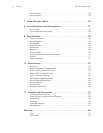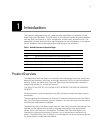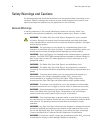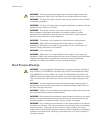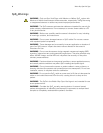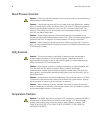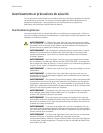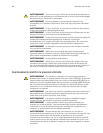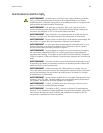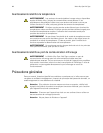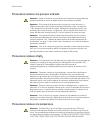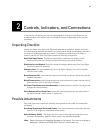
8 Welch Allyn Spot Vital Signs
Blood Pressure Cautions
SpO
2
Cautions
Temperature Cautions
Caution Extremity and blood pressure cuff motion should be minimized during
blood pressure determinations.
Caution If the blood pressure cuff is not at heart level, the difference in reading
due to the hydrostatic effect should be noted. The value of 1.80 mmHg must be
added to the displayed reading for every inch (2.5 cm) above heart level. The
value of 1.80 mmHg must be subtracted from the displayed reading for every
inch (2.5 cm) below heart level.
Caution Proper blood pressure cuff size and placement is essential to the
accuracy of the blood pressure determination. See “Chart for Determining Blood
Pressure Cuff Size” on page 23 for blood pressure cuff sizing information.
Caution When measuring blood pressure on children younger than 3 years of
age, it is recommended that the Pressure Preset (initial inflation pressure) be set
at 160 mmHg or lower.
Caution The pulse oximeter is calibrated to determine the percentage of
arterial oxygen saturation of functional hemoglobin. Significant levels of
dysfunctional hemoglobin such as carboxyhemoglobin or methemoglobin may
affect the accuracy of the measurement.
Caution Physiological conditions, medical procedures, or external agents that
may interfere with the pulse oximeter’s ability to detect and display
measurements include dysfunctional hemoglobin, arterial dyes, low perfusion,
dark pigment, and externally applied coloring agents such as nail polish, dye, or
pigmented cream.
Caution Some sensors may not be appropriate for a particular patient. If at least
15 seconds of perfusion pulses cannot be observed for a given sensor, change
sensor location or sensor type for perfusion to resume.
Caution When selecting a sensor, consider the patient’s weight and activity
level, the adequacy of perfusion, the available sensor sites, the need for sterility,
and the anticipated duration of monitoring.
Caution The Welch Allyn Spot Vital Signs is FDA cleared to measure the axillary
temperature in Normal Mode for children under the age of 4. Normal Mode
axillary temperatures may not be accurate on older children or adults. THE
WELCH ALLYN SPOT VITAL SIGNS IS NOT INTENDED TO BE USED ON
NEONATAL PATIENTS.



